According to the United States National Arboretum, there are approximately 23 species of Hydrangea. Only five of these are cultivated in the United States. These species are Anomala, Arborescens, macrophylla, Paniculata and Quercifolia. Depending on the species, hydrangeas can be planted in just about any location. No matter what species you choose, you can guarantee that the Hydrangea will provide long lasting blooms in the garden.
Everything You Need to Know About Heavenly Hydrangeas!
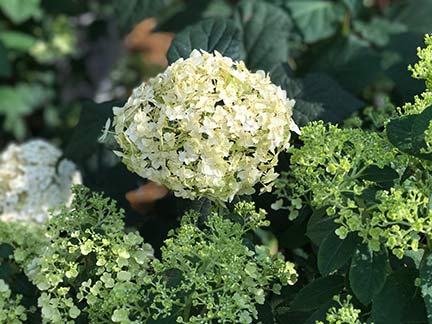
Hydrangea Arborescens
The arborescens, or the smooth hydrangea is native to moist or rocky wooded slopes, ravines, stream banks and bluff bases in our area. The grayish brown stems have serrated, dark green leaves with pale green undersides. In the fall the leaves turn yellow. Tiny white flowers bloom From late spring to mid summer flattened hairy clusters. The most common varieties are Annabelle and Incrediball.
Arborescens Care and Growing Tips
SOIL
All arborescens prefer to be planted in moist, well drained soil. Adding organic matter to soil will help with drainage.
WATER
They are intolerant of drought and should be watered weekly to establish the plant and promote a good root system. When the temperatures soar and we are not getting rain, be sure to give them additional water. Adding a layer of mulch around the base of the plant will help keep the soil moist and control weeds.
LIGHT
Arborescens do best in part shade to part sun. The bloom production will be heavier if given a bit more morning light or dappled afternoon shade.
FERTILIZING
Fertilize in the spring and then again in late summer, no later than August. We recommend using organics as they are better for the soil and are non burning. We will be happy to help you select the proper fertilizers.
PRUNING
Arborescens blooms on new wood. The entire shrub can be cut back 1-2′ above ground in late winter each year to revitalize it and to encourage vigorous stem growth and best form.
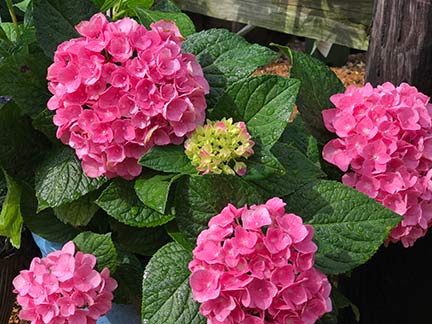
Hydrangea Macrophylla
Macrophylla, or commonly known as Mopheads, Bigleaf or Lacecaps are the most popular hydrangeas grown in home gardens and landscapes. The blooms can be blue, pink or shades of purple, depending on the pH (acidity) of the soil. Some can even be white. Some varieties of macrophyllas bloom on old wood, producing one flush of blooms per season. Other varieties bloom on both old and new wood. This means they are rebloomers, typically blooming from late spring until fall.
Macrophylla Care and Growing Tips
SOIL
All macrophyllas prefer to be planted in moist, well drained soil. Adding organic matter to soil will help with drainage.
WATER
Macrophyllas do not like to be dry, but not overly wet. They should be watered weekly to establish the plant and promote a good root system. When the temperatures soar and we are not getting rain, be sure to give them additional water. Adding a layer of mulch around the base of the plant will help keep the soil moist and control weeds.
LIGHT
Macrophyllas do best in part shade to shade. The bloom production will be heavier if given a bit more morning light or dappled afternoon shade.
COLOR
To encourage blue flowers, the pH need to be lowered. We recommend using Espoma Organic Soil Acidifier to the soil several times per year, beginning in fall and repeating before leaves emerge in spring and before the buds set. To encourage pink flowers the pH needs to be raised. We recommend adding Garden Lime. Some hydrangeas are not affected by the addition of these products and are noted as such.
Pruning Hydrangeas that bloom on old wood
The flower buds are set after flowering on the old limbs for the following spring. These varieties should only be pruned after flowering. These varieties bloom in the summer. Remove dead limbs as well as branches that are crossing over each other, or rubbing each other. Rubbing can create entry point for insects and disease. The interior of the plant can be thinned a bit to open it to more light and air.
Pruning Reblooming hydrangeas, that bloom on both old and new wood
Prune in early spring. Remove dead limbs as well as branches that are crossing over each other. The interior of the plant can be thinned a bit to open it to more light and air. Removing the spent (dead) flowers will encourage reblooming.
FERTILIZING
Fertilize in the spring and then again in late summer, no later than August. We recommend using organics as they are better for the soil and are non burning. We will be happy to help you select the proper fertilizers.
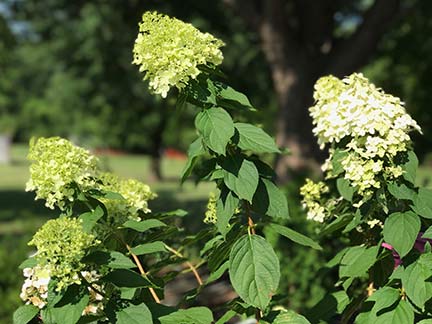
Hydrangea Paniculata or Panicle Hydrangea
Macrophylla, or commonly known as Mopheads, Bigleaf or Lacecaps are the most popular hydrangeas grThis is the most cold hardy member of the hydrangea family and is a reliable grower in the St. Louis area. The paniculata is native to Asia, and it grows 1-15’ tall. It has large creamy-white flowers, which grow on 6-18” long panicles, that bloom in mid-summer. As the flowers mature, some varieties may turn pink or some green. These shrubs are commonly pruned into a tree form. They are urban tolerant plants holding up well to pollution. The soil pH does not affect the color.own in home gardens and landscapes. The blooms can be blue, pink or shades of purple, depending on the pH (acidity) of the soil. Some can even be white. Some varieties of macrophyllas bloom on old wood, producing one flush of blooms per season. Other varieties bloom on both old and new wood. This means they are rebloomers, typically blooming from late spring until fall.
Paniculata Care and Growing Tips
SOIL
Plant in rich, well drained soil amended with organic matter.
WATER
They should be watered weekly to establish the plant and promote a good root system. When the temperatures soar and we are not getting rain, be sure to give them additional water. Adding a layer of mulch around the base of the plant will help keep the soil moist and control weeds. Once established they will tolerate some drought.
LIGHT
Panicle hydrangea grows best in full sun to part shade.
FERTILIZING
Feed the plant in early spring, just before new leaves begin to bud and again in summer when the flowers bloom. We recommend using organics as they are better for the soil and are non burning. We will be happy to help you select the proper fertilizers.
PRUNING
Paniculatas bloom on new growth and should be pruned in late winter or early spring before they flush out. You can cut it back close to the ground or, if you want slightly taller plants, cut it back to one to three feet. Make sure to remove the dead limbs and branches that are crossing, or rubbing each other. Rubbing can create entry point for insects and disease. Larger flower panicles can be obtained by thinning the plants to 5-10 primary shoots.
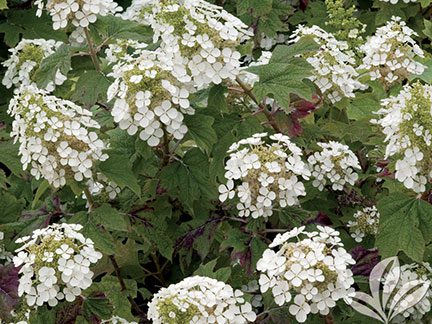
Hydrangea Quercifolia or the Oakleaf Hydrangea
The oakleaf hydrangea is one of two Hydrangea species that is native to the United States. It is found growing primarily in moist woodlands in the southeastern U.S. They generally grow 6-8’ tall. Oakleaf Hydrangeas have large panicles of creamy white flowers that grow 4-12” in length in early summer. As flowers age, they often turn a medium to deep-rose color. The leaves are large and deeply lobed, resembling a big oak leaf. Oakleaf hydrangea is the only member of the hydrangea family to develop significant fall foliage color. The foliage turns a deep mahogany-red and will remain on the plant until late fall or early winter. It has exfoliating bark, giving it winter interest. Oakleaf hydrangeas come in two forms – single blossom and double blossom. The soil pH does not affect the flower color. No matter what variety, they all make great cut and dried flowers.
Quercifolia Care and Growing Tips
SOIL
Plant in rich, well drained soil amended with organic matter.
WATER
They should be watered weekly to establish the plant and promote a good root system. When the temperatures soar and we are not getting rain, be sure to give them additional water. Adding a layer of mulch around the base of the plant will help keep the soil moist and control weeds. The like moist, not soggy soil conditions.
LIGHT
Quercifolias grows best in part shade to part sun. Best when given afternoon shade.
FERTILIZING
Feed the plant in early spring, just before new leaves begin to bud and again in late summer. We recommend using organics as they are better for the soil and are non burning. We will be happy to help you select the proper fertilizers.
PRUNING
Oakleaf hydrangeas bloom on old wood (last year’s growth), and should be pruned to shape after blooming if desired, so they have time to grow new branches to bloom next year. You can leave the flowers on for winter interest or for cutting and drying.
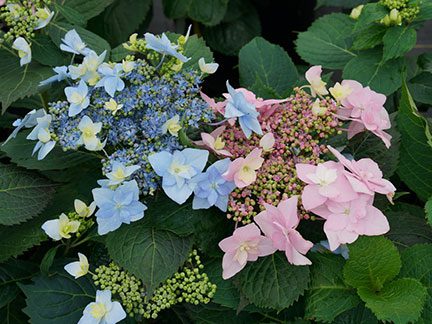
Hydrangea Serrata – Mountain Hydrangea or Tea of Heaven
This hydrangea is similar to a macrophylla except it is a smaller more compact shrub with smaller flowers and leaves. It was formerly listed and sold as Hydrangea macrophylla var. serrata. It is native to moist woodland mountain valleys in Japan. It is a deciduous shrub with a rounded habit. It generally features serrated, oval shaped green leaves, and long-blooming summer flowers. The leaves can be used to make a sweet tea, hence the sometimes used common name.
Serrata Care and Growing Tips
SOIL
Plant in rich, well drained soil amended with organic matter.
WATER
They should be watered weekly to establish the plant and promote a good root system. When the temperatures soar and we are not getting rain, be sure to give them additional water. Adding a layer of mulch around the base of the plant will help keep the soil moist and control weeds. The like moist, not soggy soil conditions.
LIGHT AND LOCATION
Grows best in part shade. Does best when planted in protected location
COLOR
To encourage blue flowers, the pH need to be lowered. We recommend using Espoma Organic Traditions® Soil Acidifier to the soil several times per year, beginning in fall and repeating before leaves emerge in spring and before the buds set. To encourage pink flowers the pH needs to be raised. We recommend adding Espoma Organic Traditions® Garden Lime. Some hydrangeas are not affected by the addition of these products and are noted as such.
FERTILIZING
Feed the plant in early spring, just before new leaves begin to bud and again in late summer. We recommend using organics as they are better for the soil and are non burning. We will be happy to help you select the proper fertilizers.
PRUNING
Serrata blooms on new wood and should be pruned in late winter or early spring. Remove weak or winter damaged stems and dead branches.

